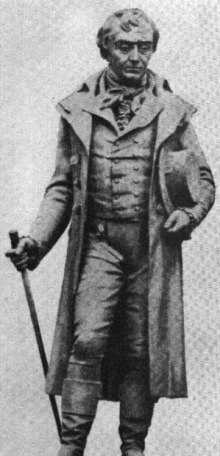Nicolas Leblanc
Nicolas Leblanc (born December 6, 1742 in Ivoy-le-Pré , † January 16, 1806 in Saint Denis ) was a French doctor , chemist and manufacturer . He is known for a groundbreaking process for producing soda , a key technology in chemistry ( Leblanc process ).
Live and act
Nicolas's father was a hut manager, but the family was not wealthy. Before studying medicine, he went to school in Issoudun . From 1759 Nicolas Leblanc studied medicine and chemistry at the Paris Surgery School Académie royale de Chirurgie . Here he met Antoine François de Fourcroy know; through his suggestions he will deal with chemistry beyond medicine. First he practiced as a country doctor for the next twelve years. At the age of 38 he received an offer to work as a personal physician. In 1780 he became a physician to the family of Louis Philippe d'Orléans . The Duke of Orléans had a similar scientific interest, chemistry. Leblanc was able to work freely in the Duke's private laboratory.
At first he dealt with the aluminum salt alum . He found that alum produced different crystal forms ( polymorphism ) depending on the basicity of the solution in which it crystallized . 1786–1787 Leblanc made an elaboration on the crystallization of alum and cobalt sulfate and submitted this work to the Academy of Sciences in Paris, Académie des Sciences . The tenor of the work was that salts of similar composition have the same crystal form.
The soda production
Leblanc's next project was about soda . Natural soda was made from wood ash or from the ashes of sea and beach plants. Larger soda deposits were also known in Egypt and smaller deposits in Hungary. Soda was used in glass making, soap making and bleaching plants. Before 1791, France obtained soda from Spain, but the warlike involvement after the French Revolution made the soda supply worse.
The Academy of Sciences in France now put a fairly high price on the artificial manufacture of soda. Preparatory work on the production of soda has already been carried out by many other chemists such as Henri Louis Duhamel du Monceau (who demonstrated the principle of production from table salt using Glauber's salt ), Andreas Sigismund Marggraf , Johann Heinrich Hagen, Karl Wilhelm Scheele , Joseph François Malherbe , Jean-Claude Delamétherie . Marggraf has already been able to produce soda by heating sodium nitrate and coal together. In 1777 Malherbe had developed a process for making sodium sulfide by heating sodium sulfate , coal and iron. De la Métherie converted the sodium sulfide into soda by heating it with acetic acid. A small factory near Paris worked according to this procedure.
In 1789, Leblanc achieved a breakthrough in this area based on this. Leblanc uses the ideas of Malherbe, Malherbe and De la Méthiere, but does not use acetic acid, but abundant limestone . In the reaction with sodium sulfide, the insoluble calcium sulfide and the readily water-soluble sodium carbonate were formed. Leblanc applied for a patent on this development and the Duke of Orléans financed the factory production of soda. From 100 pounds of sodium sulfate with crystal water ( Glauber's salt ), 100 pounds of limestone, 50 pounds of coal, 150 pounds of soda were obtained. After the first attempts in 1789, he deposited the description of his procedure with a notary in Paris in 1790. On January 27, 1791, he signed a contract to manufacture it in London, and on September 19, he was granted a patent for it.
In November 1793 the Duke of Orléans was beheaded, his property was confiscated and the soda factory operated jointly with Leblanc was closed. In 1794 the Welfare Committee canceled Leblanc's patent and made the patent available to all French citizens without a license due to the difficult import conditions for soda. Leblanc, now 52 years old, was materially ruined. In an unpaid honorary position, he was assigned jobs in administration and as a manager of a powder factory. In 1798 he was still a member of the council of the elderly. His daughter fell ill and died that same year. In 1805, Leblanc was recognized by the court, but the sum was never paid out. His wife became ill and the family was destitute. In January 1806, Leblanc ended his life by a pistol shot in the poor house in St. Denis.
The Leblanc process was the predominant large-scale industrial process for producing soda for around 100 years. It was only replaced by the Solvay process .
literature
- Günther Bugge: The book of the great chemists . Verlag Chemie GmbH, Weinheim 1974, ISBN 3-527-25021-2 , p. 291 ff.
Web links
Individual evidence
- ^ Archives of Pharmacy , Volume 223, p. 866. Deutscher Apotheker-Verein, Hanover, 1885.
- ↑ Romain Guignard: Pèrsonnages et monuments d'Issoudun S. 9. H. Gaignault & fils, 1946th
- ↑ Ernst F. Schwenk: Great moments in early chemistry. Beck, 2000, p. 52
- ↑ Ernst F. Schwenk: Great moments in early chemistry. Beck, 2000, p. 54
| personal data | |
|---|---|
| SURNAME | Leblanc, Nicolas |
| BRIEF DESCRIPTION | French doctor, chemist and manufacturer |
| DATE OF BIRTH | December 6, 1742 |
| PLACE OF BIRTH | Ivoy-le-Pré , Berry , France |
| DATE OF DEATH | January 16, 1806 |
| Place of death | Saint-Denis , Seine department , France |
